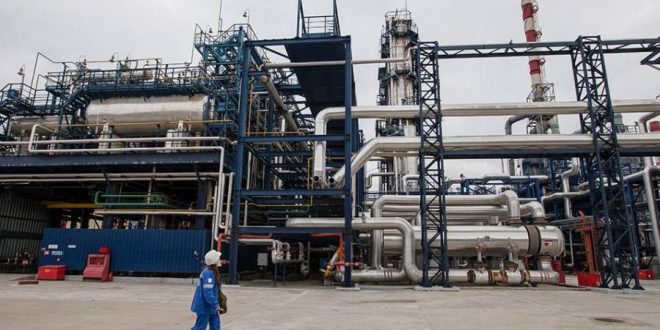Russia will propose that participants in the OPEC non-OPEC production cut deal be allowed a `proportional increase` in output to moderate oil prices and fill any supply. a source told S&.P Global Platts.
Such moves would still result in a net 1 million b d supply cut as participants have actually lowered output by 2.8 million b d. largely due to Venezuela`s involuntarily free-falling production. the source said.
The production cut agreement. which went into force in January 2017. called for a 1.8 million b d cut from October 2016 levels.
Russia`s President Vladimir Putin is expected to discuss the deal with Saudi Arabia`s Crown Prince Mohammed bin Salman Thursday. ahead of the World Cup opening ceremony and match between the two countries.
Russia`s cooperation with the OPEC coalition will be among the meeting`s agenda items. Putin`s spokesman. Dmitry Peskov. said Wednesday. according to the country`s RIA Novosti news agency. But a gradual withdrawal from the deal is not on the agenda. he added.
Saudi energy minister Khalid al-Falih and his Russian counterpart Alexander Novak. are also expected to meet during the visit to discuss the output cut agreement.
The Russian-Saudi meeting will occur just days before OPEC gathers on June 22 in Vienna to review its supply cut agreement with key non-OPEC producers led by Russia.
And it comes as US President Donald Trump lobbies OPEC to lower oil prices. which. for the second time on Twitter. he has said are `too high.`
`OPEC is at it again. Not good!` Trump tweeted Wednesday.
Iran. Venezuela and Iraq have voiced opposition to suggestions that OPEC raises its output.
The Russian energy ministry declined to comment. while Novak has previously said repeatedly that a proportional increase in quotas would be logical if the coalition decides to raise crude production.
In late May. Falih and Novak both said the OPEC-led coalition could start gradually raising oil production as early as the third quarter. after prices rose above $80 b.
Russian production stood at 11.2 million b d in October 2016. while Saudi output was 10.5 million b d. OPEC as a whole produced 31 million b d in October 2016. not including Indonesia. which suspended its membership in November 2016. and Equatorial Guinea. which joined the organization in May 2017.
RUSSIAN PRODUCERS READY FOR RISE
Russia`s oil producers have also called for `flexible` quotas recently as the key goal of the agreement — to bring OECD commercial oil inventories down to the five-year average — has been achieved.
Russia had never previously reduced its production intentionally. so it remains unclear how much time it would need to restore the output.
Rosneft has said it could fully recover the 100.000 b d it cut in line with the agreement within two months if the terms were lifted.
In tests carried out over three days. the company boosted output by 57.000 b d on day one. 70.000 b d on day two. and an expected 80.000-85.000 b d on day three. Aton analysts said earlier this month. after meeting with Rosneft`s top officials.
Lukoil`s CEO Vagit Alekperov also spoke in favor of reconsidering the output limits due to `already high` oil prices. while Gazprom Neft First Deputy CEO Vadim Yakovlev said his company is prepared to restore its production. which was reduced by about 34.000 b d. within a month or two.
PRICE UNDER SCRUTINY
Russia has received significant additional earnings from a 40% increase in oil prices over the course of the production cut deal. Current oil prices. though. seem too high and unstable for Russia as they pose risks of new price hikes and also add pressure on the domestic market.
Russia has recently faced a significant jump in domestic motor fuel prices. which has raised nationwide concern ahead of the high-demand harvesting season. with the authorities even warning they would need to increase export duty for oil products to limit deliveries to international markets.
The situation has improved slightly recently as the cut in oil prices by around $5 b from $80 b in late May increases the profitability of domestic refining and reduces the attractiveness of `the export alternative.` Novak said Wednesday.
`If the trend persists and prices reach. say. $70 b on international markets. then [the domestic] situation may fully stabilize.` he said.
President Putin in late May said Russia could be comfortable with an oil price of $60 b as this level allowed the country to plan and implement investment. adding it was not interested in ever rising prices because these could cause problems for customers.
 Iran Energy News Oil, Gas, Petrochemical and Energy Field Specialized Channel
Iran Energy News Oil, Gas, Petrochemical and Energy Field Specialized Channel




